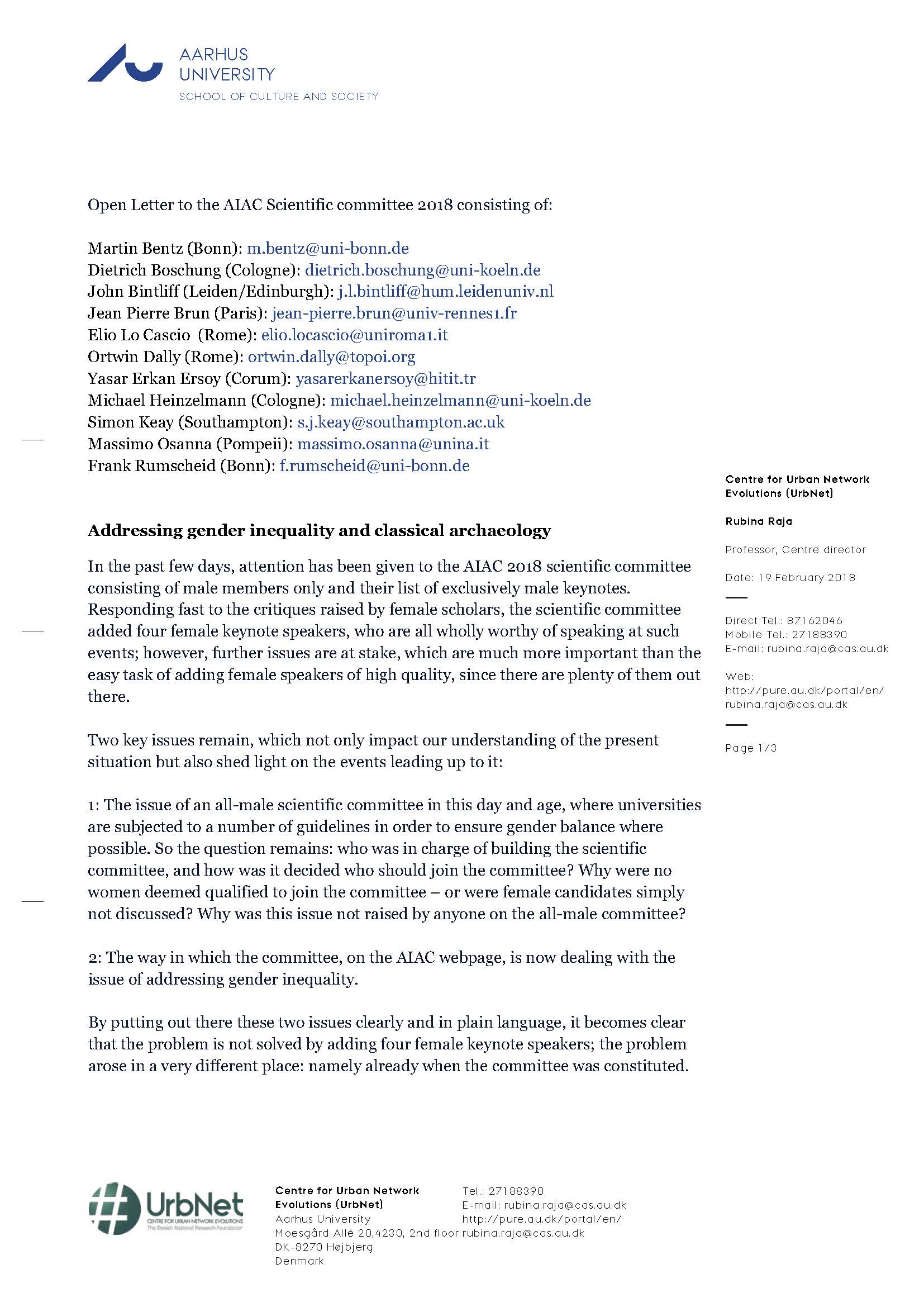Addressing gender inequality and classical archaeology
Open Letter to the AIAC Scientific committee 2018.

Open Letter to the AIAC Scientific committee 2018 consisting of:
Martin Bentz (Bonn): m.bentz@uni-bonn.de
Dietrich Boschung (Cologne): dietrich.boschung@uni-koeln.de
John Bintliff (Leiden/Edinburgh): j.l.bintliff@hum.leidenuniv.nl
Jean Pierre Brun (Paris): jean-pierre.brun@univ-rennes1.fr
Elio Lo Cascio (Rome): elio.locascio@uniroma1.it
Ortwin Dally (Rome): ortwin.dally@topoi.org
Yasar Erkan Ersoy (Corum): yasarerkanersoy@hitit.tr
Michael Heinzelmann (Cologne): michael.heinzelmann@uni-koeln.de
Simon Keay (Southampton): s.j.keay@southampton.ac.uk
Massimo Osanna (Pompeii): massimo.osanna@unina.it
Frank Rumscheid (Bonn): f.rumscheid@uni-bonn.de
Addressing gender inequality and classical archaeology
In the past few days, attention has been given to the AIAC 2018 scientific committee consisting of male members only and their list of exclusively male keynotes. Responding fast to the critiques raised by female scholars, the scientific committee added four female keynote speakers, who are all wholly worthy of speaking at such events; however, further issues are at stake, which are much more important than the easy task of adding female speakers of high quality, since there are plenty of them out there.
Two key issues remain, which not only impact our understanding of the present situation but also shed light on the events leading up to it:
1: The issue of an all-male scientific committee in this day and age, where universities are subjected to a number of guidelines in order to ensure gender balance where possible. So the question remains: who was in charge of building the scientific committee, and how was it decided who should join the committee? Why were no women deemed qualified to join the committee – or were female candidates simply not discussed? Why was this issue not raised by anyone on the all-male committee?
2: The way in which the committee, on the AIAC webpage, is now dealing with the issue of addressing gender inequality.
By putting out there these two issues clearly and in plain language, it becomes clear that the problem is not solved by adding four female keynote speakers; the problem arose in a very different place: namely already when the committee was constituted.
Since the committee, obviously without anyone on the committee questioning its composition, came to consist only of male classical archaeologists, it is no wonder that the invited keynote speakers also turned out to be male only. Gender blindness is not a crime – and it often goes both ways. However, that is why mixed-gender committees are important, in order to confront such pitfalls and act fairly. This, hopefully, is a lesson learned for the AIAC.
The second issue is much more pressing, being acutely relevant, and goes to show how the AIAC committee decided to act in response to critique that was voiced calmly and professionally.
This is the text that was released on the AIAC webpage (quote): In response to an ongoing discussion we propose a new panel in session 12 "Gender issues and Classical Archaeology". Suggestions on its format are welcome.
The AIAC scientific committee proposes a panel on Gender Issues and Classical Archaeology and welcomes suggestions for its format; however, the committee does not take any responsibility, nor does it suggest how to address such a theme. While it certainly is admirable that suggestions on the format are welcome, a larger problem remains unaddressed: who should take the lead on such a panel? Should it be the female scholars who were ignored as potential members of the committee in the first place? Should it be the female keynote speakers to whom an invitation was extended within the last few days? Should it be the female postdocs and non-tenured assistant professors out there who need to make a name for themselves and who will all be applying for jobs, for which the selection will be handled by male-dominated committees? Or should it be female PhD students who might be reluctant to voice openly what they think because they might be stigmatised as feminists? The response of the AIAC committee, unfortunately, has not been sufficient at all, and proper engagement with the issue at large is lacking.
Furthermore, a third issue must be brought out in the open: the AIAC proudly advertises the co-operating funding bodies of the conference. One has to wonder what these funding bodies think of this situation, and how such prominent funding bodies and research councils could allow this situation to arise in the first place? Most funding bodies these days – just like universities – have explicit gender policies, which are to ensure that grant holders think carefully about how they put together committees and programmes and invite people.
Adding four female keynote speakers – after having advertised exclusively with male keynotes for a long time – is easy, and the issues raised above present the much more difficult tasks, which have so far been ignored by the AIAC scientific committee. It will be important for the committee to address these issues seriously at the AIAC in May 2018, and one suggestion is that they plan such panels themselves and take the initiative to discuss the issues openly, and that they invite key experts who could add useful perspectives and recommendations for how to fix the long-prevalent gender imbalance in the discipline.
Rubina Raja
Professor of Classical Archaeology
Centre director, The Danish National Research Foundation’s Centre of Excellence for Urban Network Evolutions
Member of the Royal Academy of Sciences and Letters, Copenhagen, Denmark
Member of the Young Academy of Europe
